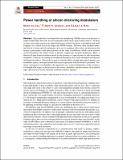Power handling of silicon microring modulators
Author(s)
de Cea Falco, Marc; Atabaki, Amir H; Ram, Rajeev J
DownloadPublished version (2.102Mb)
Publisher Policy
Publisher Policy
Article is made available in accordance with the publisher's policy and may be subject to US copyright law. Please refer to the publisher's site for terms of use.
Terms of use
Metadata
Show full item recordAbstract
Silicon photonic wavelength division multiplexing (WDM) transceivers promise to achieve multi-Tbps data rates for next-generation short-reach optical interconnects. In these systems, microring resonators are important because of their low power consumption and small footprint, two critical factors for large-scale WDM systems. However, their resonant nature and silicon’s strong optical nonlinearity give rise to nonlinear effects that can deteriorate the system’s performance with optical powers on the order of milliwatts, which can be reached on the transmitter side where a laser is directly coupled into resonant modulators. Here, a theoretical time-domain nonlinear model for the dynamics of optical power in silicon resonant modulators is derived, accounting for two-photon absorption, free-carrier absorption and thermal and dispersion effects. This model is used to study the effects of high input optical powers over modulation quality, and experimental data in good agreement with the model is presented. Two major consequences are identified: the importance of a correct initialization of the resonance wavelength with respect to the laser due to the system’s bistability; and the existence of an optimal input optical power beyond which the modulation quality degrades.
Date issued
2019-08Department
Massachusetts Institute of Technology. Research Laboratory of ElectronicsJournal
Optics Express
Publisher
Optical Society of America (OSA)
Citation
de Cea, Marc et al. "Power handling of silicon microring modulators." Optics Express 27, 17 (August 2019): 24274-24285 © 2019 Optical Society of America
Version: Final published version
ISSN
1094-4087